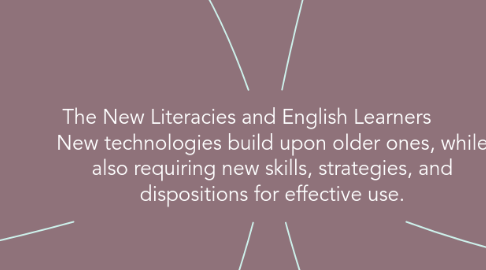
1. Build on background knowledge and vocabulary using hyperlinks, this is also a good way to offer individualized, on-the-spot scaffolds to comprehension, facilitating both language developments of content learning.
2. Differentiated Instruction Using Technology
2.1. Express learning in different modes
2.2. Cultural knowledge & Interest
2.2.1. Consider students strengths, abilities, and personality traits to properly implement differentiated instruction that builds on individual characteristics.
2.2.1.1. Another great way to build on cultural background and students interest is by using story telling apps that allow students to work individually and they can share their work remotely with other classmates. An example would be a research topic project on festivals. They could choose to do a festival in America or their home country and use the storytelling app to be their final presentation method.
2.3. Proficiency
2.3.1. Consider their English language development levels in order to provide scaffolding that enabled your ELs to comprehend and participate successfully in learning activities.
2.3.1.1. Make sure students can access information in their primary languages or through English text that has been modified for use by English Learners.
3. Resources for Teachers and Students ***
3.1. ESLgamesplus (Website that has games linked directly from the site)
3.1.1. Interactive board games (helps to develop skills in English grammar and vocabulary).
3.1.2. Memory and concentration games (these can help develop skills in recognition, listening, reading and spelling skills).
3.1.3. Sentence and grammatical structure games
3.2. Monkey Puzzles (available in app format)
3.2.1. This game is a easy game for Elementary students, it’s a matching game that begins with just 1 or 2 words and builds up to matching full sentences with pictures that correlate.***
3.3. These resources are a great way to implement differentiated learning and have individualized plans for each student, especially those on different levels of proficiency. ***
4. Web 2.0 technologies permits interaction and collaboration on websites (blogs, wikis, podcasts).
4.1. Group research projects are a great way to use the Internet for collaboration. They offer students opportunities to use new technologies for academic learning.
5. Safe and Effective Use of the Internet
5.1. Online Reading
5.1.1. Internet reading requires greater cognitive involvement and critical thinking than traditional book learning.
5.1.1.1. Reading online is multimodal, requiring readers to interpret additional aural, visual, and verbal cues: for example, graphs, pictures, video, verbal commentary, and music.
5.2. How to be Safe and Responsible
5.2.1. Follow these steps to teach students to evaluate the reliability and accuracy of the information and websites. (Found in the book on page 139) 1. Know and implement the school guidelines for internet use and safety. 2. Let the teacher know what you are doing on the web. 3. Get parental approval. 4. Learn about the safest site before use. 5. Discuss what students may or may not post online. 6. Review valuable safety information 7. Publish the list in English and in the students other languages so they may share and explain information to their parents or other family members.
5.3. Website Evaluation
5.3.1. In addition to knowing how to safely and responsibly use the internet it’s important to make sure students learn how to critically evaluate online information (bias, reliability, and accuracy).
5.3.1.1. Students should create clear, well-defined questions so that they can look for information that is directly relevant to answering the questions.
5.3.1.2. Hyperlinks offer students the choice to go to different web pages that may define, clarify, or dive deeper into a particular topic.
6. Using Web 1.0 and 2.0 Programs for Learning
6.1. Starting students out on Web 1.0 and Web 2.0 technology properly and efficiently helps to prepare them for the future in a fast growing technology advanced world. ***
6.1.1. Hey
6.2. Social Networking (Make sure that students are following guidelines outlined on NEA “schools and online social networking” as well as district regulations)
6.2.1. Social networking allows students to connect with outer classrooms even in other countries
6.2.2. Social networking can give teachers and students a chance to learn about safety, ethics, and politeness on the net
6.2.3. Social networking facilitates communication among students as they work collaboratively on projects in academic content areas.
